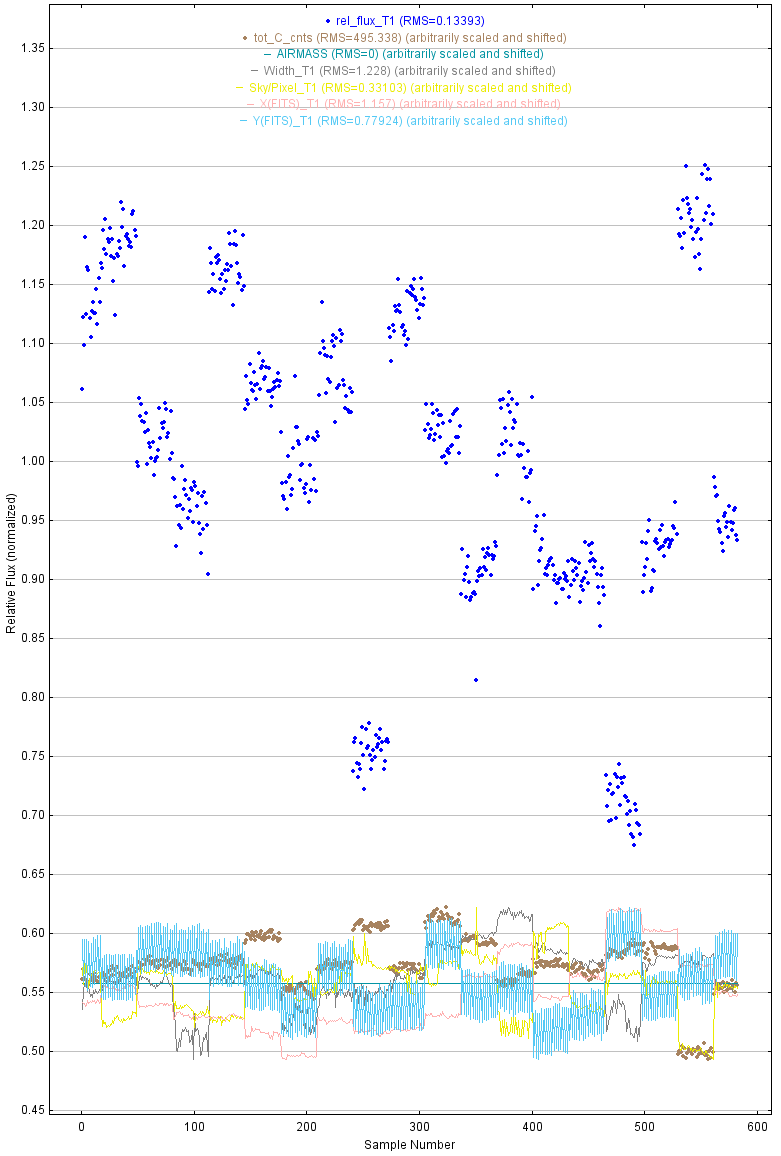Re: photometry on video using AstroImageJ
Posted by karenacollins on Apr 14, 2021; 6:53am
URL: http://astroimagej.170.s1.nabble.com/photometry-on-video-using-AstroImageJ-tp1548p1549.html
Hi Alnair,
I didn't have any problem running photometry on your AVI file (see below) using AIJ 3.4.0.25 running under Windows 10 and Java 64 bit. See the image and light curve below.
One issue is that the AVI file format does not provide fits headers (of course). The fits headers contain timing information that AIJ uses to extract timing to display on the light curve plot. I believe in older AIJ versions, AIJ would hang if no timing information was found. Ensure that you have updated AIJ to the latest daily build following these instructions:
http://astroimagej.1065399.n5.nabble.com/After-a-fresh-installation-of-AIJ-be-sure-to-update-to-the-latest-build-td142.html
If that doesn't solve the problem, click the lower portion of the AIJ Toolbar and report the information displayed in the lower part of the Toolbar. Also report the OS you are running. Also include a screen grab of the Multi-plot set-up panel before you click "Place Apertures".
Karen


URL: http://astroimagej.170.s1.nabble.com/photometry-on-video-using-AstroImageJ-tp1548p1549.html
Hi Alnair,
I didn't have any problem running photometry on your AVI file (see below) using AIJ 3.4.0.25 running under Windows 10 and Java 64 bit. See the image and light curve below.
One issue is that the AVI file format does not provide fits headers (of course). The fits headers contain timing information that AIJ uses to extract timing to display on the light curve plot. I believe in older AIJ versions, AIJ would hang if no timing information was found. Ensure that you have updated AIJ to the latest daily build following these instructions:
http://astroimagej.1065399.n5.nabble.com/After-a-fresh-installation-of-AIJ-be-sure-to-update-to-the-latest-build-td142.html
If that doesn't solve the problem, click the lower portion of the AIJ Toolbar and report the information displayed in the lower part of the Toolbar. Also report the OS you are running. Also include a screen grab of the Multi-plot set-up panel before you click "Place Apertures".
Karen


On 4/13/2021 2:07 PM, Alnair [via
AstroImageJ] wrote:
Hi,
From some types of astronomical events (i.e. star occultations by minor planets) fast photometry was required in order to get useful results, so many astronomers registered the phenomenon with high sensitivity video cameras with precise time leveling taken from a GPS device.
Here is a sample still image of a such videos:
AstroImageJ seems to understand the video format (AVI uncompressed) it shows all the frames (just letf-right mirrored).
However, multi aperture photometry doesn't work. After setting up the apertures it doesn't start processing the images.
This is how AstroImageJ looks after pressing <Enter> to start processing:
It would be nice if it works, since AstroImageJ is better on photometry (in my opinion) than other alternatives other astronomers use.
Here is a sample uncompressed video (warning, 346 Mb)
Maybe it's easy to solve. It seems it nearly works.
Thanks,Ferran Casarramona
If you reply to this email, your message will be added to the discussion below:http://astroimagej.1065399.n5.nabble.com/photometry-on-video-using-AstroImageJ-tp1548.htmlTo start a new topic under AstroImageJ, email [hidden email]
To unsubscribe from AstroImageJ, click here.
NAML
| Free forum by Nabble | Edit this page |

